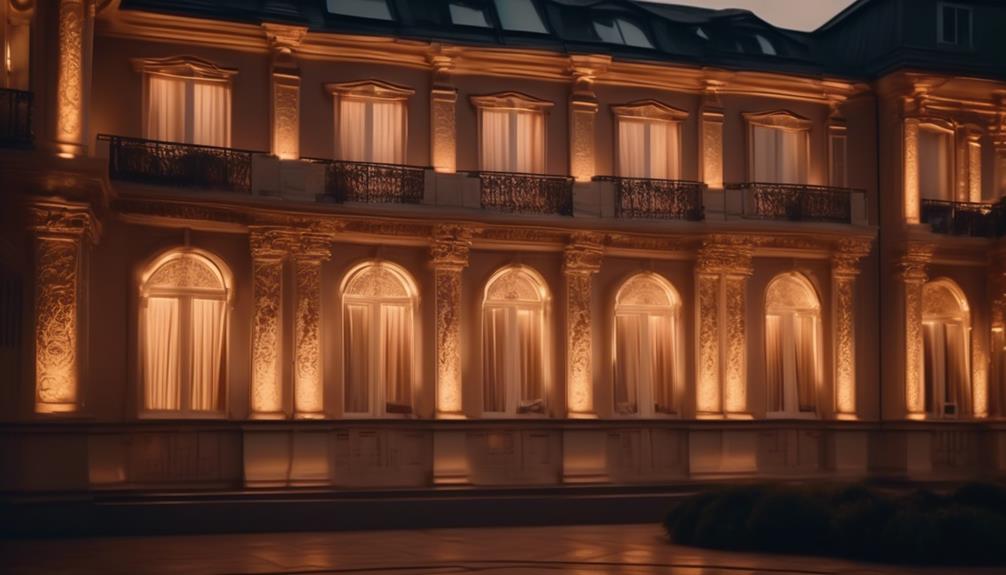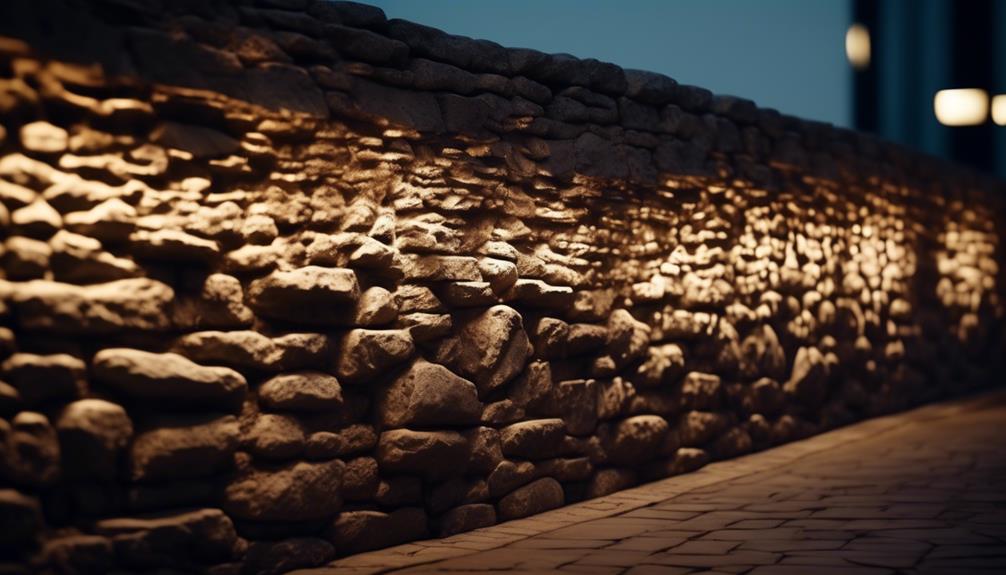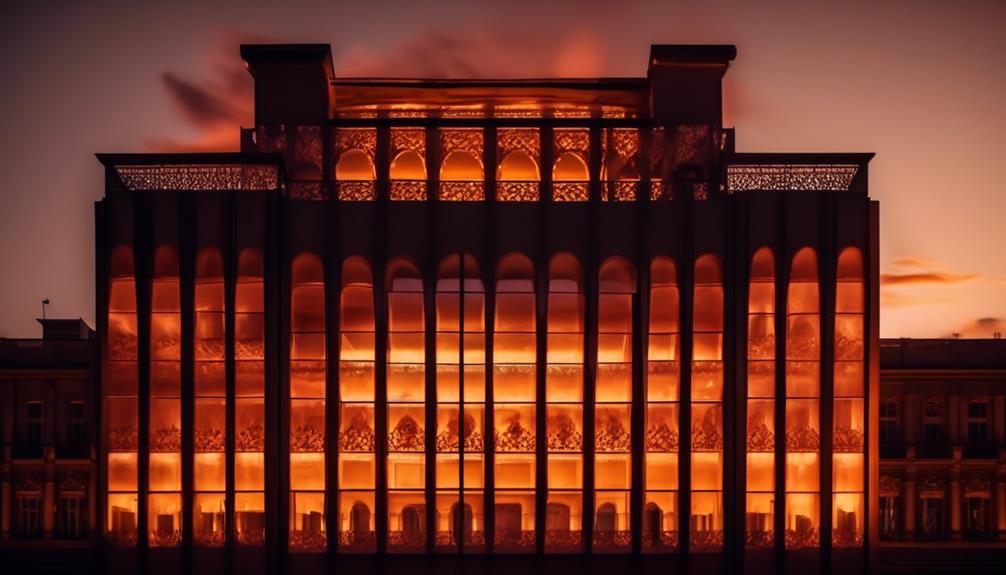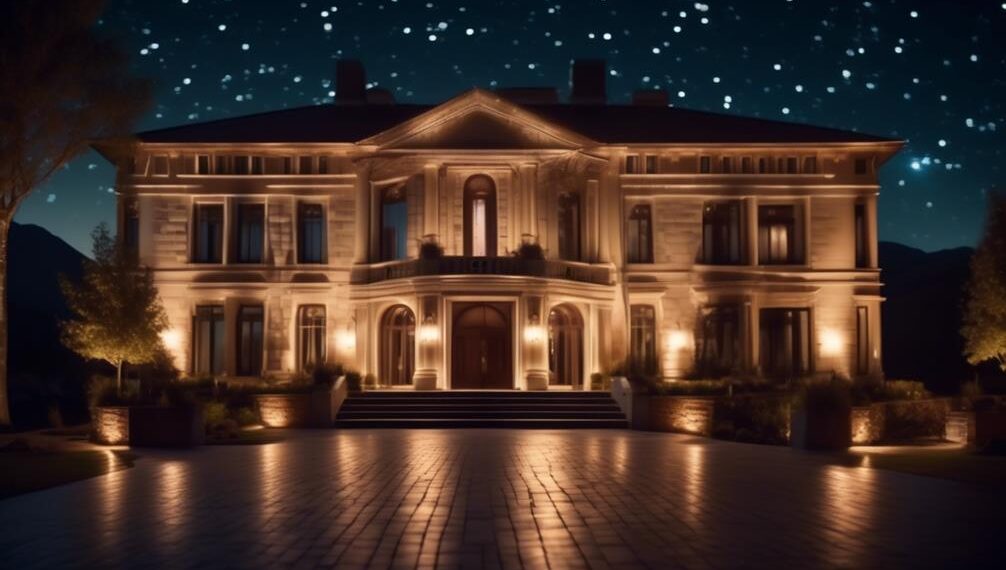Are you looking for ways to enhance the beauty and functionality of the outdoor spaces around your building?
Well, look no further because we have three essential techniques for you.
These techniques will not only illuminate your architectural features but also create a captivating ambiance that will leave everyone in awe.
So, are you ready to discover the secrets behind stunning outdoor architectural lighting?
Key Takeaways
- Uplighting creates a visually stunning effect, highlights architectural features, and enhances safety and security.
- Downlighting brings focus and ambiance to specific areas, with careful consideration of fixtures, positioning, and angle.
- Grazing enhances texture, creates dramatic shadows, and accentuates architectural details with a subtle and soft lighting effect.
- Silhouetting utilizes backlighting to create striking visual effects, add depth to the lighting design, and highlight specific objects or architectural features.
Uplighting

To enhance the architectural features of your outdoor space, uplighting can be used to create a dramatic and visually stunning effect. Uplighting techniques for highlighting architectural features provide a unique way to showcase your home or landscape design. By strategically placing lights at the base of structures, such as columns or statues, you can create a beautiful upward illumination that adds depth and dimension to your outdoor space.
One of the key benefits of uplighting in outdoor landscape design is its ability to create a sense of drama and elegance. By casting light upward, you can draw attention to specific architectural elements, making them the focal point of your outdoor space. This technique is especially effective at night, when the contrast between light and shadow is more pronounced.
In addition to adding visual interest, uplighting can also improve the overall safety and security of your outdoor area. By illuminating pathways, stairs, and other potential hazards, you can ensure that your outdoor space is well-lit and easily navigable, even after the sun sets.
When implementing uplighting techniques, it's important to carefully consider the placement of your lights. By experimenting with different angles and intensities, you can achieve the desired effect and create a truly captivating outdoor ambiance.
Downlighting

Downlighting is a versatile lighting technique that brings focus and ambiance to your outdoor space by casting light downward. This technique is commonly used in outdoor architectural lighting to highlight specific areas, create depth, and add a touch of drama to your outdoor environment. Whether you want to illuminate a pathway, accentuate a garden feature, or create a warm and inviting atmosphere on your patio, downlighting can help you achieve your desired effect.
To ensure you choose the right downlighting fixtures for your outdoor space, consider the following tips:
- Consider the application: Determine the purpose of your downlighting. Are you looking to provide general lighting, highlight specific features, or create a specific mood?
- Select the right fixture: Choose fixtures that are suitable for outdoor use and can withstand various weather conditions. Look for fixtures that are durable, waterproof, and have the appropriate level of brightness for your needs.
- Positioning and angle: Consider the placement and angle of the downlights to achieve the desired lighting effect. Experiment with different angles and positions to find the best combination that highlights your outdoor space.
- Energy efficiency: Opt for energy-efficient downlighting fixtures to reduce energy consumption and save on electricity bills. LED fixtures are a popular choice due to their longevity and low energy consumption.
Grazing

Looking to add a unique and eye-catching element to your outdoor lighting design? Consider incorporating grazing techniques into your architectural lighting plan.
Grazing is a technique that involves placing lights at a low angle to illuminate a textured surface, creating beautiful shadow play and enhancing the overall visual appeal of your outdoor space.
Here are five reasons why grazing can elevate your lighting design:
- Enhanced texture: Grazing brings out the texture of surfaces such as stone walls, brick facades, and wooden panels, adding depth and dimension to your outdoor space.
- Dramatic shadows: By casting shadows on textured surfaces, grazing creates interesting patterns and adds drama to your lighting design.
- Highlight architectural details: Grazing can be used to accentuate architectural features like columns, arches, and moldings, drawing attention to their intricate designs.
- Subtle and soft lighting: Grazing techniques provide a soft and diffused lighting effect, creating a cozy and inviting atmosphere in your outdoor area.
- Versatile applications: Grazing can be used with a variety of materials, making it a versatile technique that can be applied to different parts of your outdoor space.
Silhouetting

Silhouetting is a captivating technique that utilizes backlighting to create striking visual effects in your outdoor architectural lighting design. By positioning a light source behind an object, you can create a dramatic silhouette against the dark background, enhancing the overall ambiance of your outdoor space. This technique allows you to play with contrast and shadow, adding depth and intrigue to your lighting design.
To better understand the concept of silhouetting, let's take a look at the following table that highlights the key features of this technique:
| Backlighting Techniques | Contrast and Shadow Play |
|---|---|
| Positioning a light source behind an object | Creating a striking silhouette against the dark background |
| Enhancing the overall ambiance of your outdoor space | Adding depth and intrigue to your lighting design |
Silhouetting offers a sense of freedom in your outdoor architectural lighting design. It allows you to highlight specific objects or architectural features, creating a focal point that draws the eye. By carefully selecting the objects to silhouette, you can evoke a sense of mystery and drama in your outdoor space.
When implementing silhouetting in your design, consider the placement and intensity of the backlighting. Experiment with different angles and distances to achieve the desired effect. Remember to strike a balance between highlighting the silhouette and maintaining the surrounding environment's overall lighting. With silhouetting, you can create a mesmerizing outdoor lighting display that truly captivates and inspires.
Pathway Lighting

For a well-illuminated and safe outdoor pathway, consider implementing strategic pathway lighting techniques. Pathway lighting not only enhances the beauty of your landscape but also ensures safety and security as you navigate through your outdoor space.
Here are five essential techniques to consider:
- Landscape integration: Integrate pathway lighting seamlessly into your landscape design, ensuring that the lights complement the surrounding environment. Choose fixtures that blend with the natural elements and enhance the overall aesthetic appeal of your outdoor space.
- Safety and security: Illuminate your pathways to provide a safe and secure environment, especially during the night. Use lighting fixtures that evenly distribute light along the pathway, preventing any dark spots or areas that could lead to accidents or tripping hazards.
- Placement and spacing: Strategically place lighting fixtures along the pathway to ensure proper illumination. Consider the height and angle of the fixtures to achieve optimal visibility without causing glare or shadows.
- Low-level lighting: Opt for low-level lighting fixtures that emit a soft and gentle glow. This creates a warm and inviting ambiance while ensuring visibility along the pathway.
- LED technology: Choose LED lighting for your pathway as it provides energy-efficient and long-lasting illumination. LEDs are also versatile, allowing you to create different lighting effects and adjust the intensity as needed.
Implementing these pathway lighting techniques won't only enhance the beauty of your outdoor space but also ensure a safe and secure environment for you and your guests. So go ahead, explore the possibilities and create a pathway that's both functional and visually stunning.
What Are Some Essential Techniques for Outdoor Architectural Lighting?
When it comes to illuminating outdoor spaces, using the best outdoor architectural lighting techniques is essential. Incorporating techniques like uplighting, downlighting, grazing, and highlighting can help accentuate the architectural features of a building while creating a visually stunning outdoor environment. Proper placement and use of these techniques can greatly enhance the overall aesthetic appeal of any outdoor space.
Frequently Asked Questions
How Can I Incorporate Outdoor Architectural Lighting Into My Existing Landscape Design?
To incorporate outdoor architectural lighting into your existing landscape design, start by considering the placement of the lights. A well-placed light can highlight the unique features of your architecture and landscaping, creating a stunning visual effect.
Additionally, explore different lighting control options to customize the ambiance and functionality of your outdoor space. From dimmers to timers, these options allow you the freedom to adjust the lighting to suit your needs and create the perfect atmosphere.
What Are the Main Factors to Consider When Choosing Outdoor Architectural Lighting Fixtures?
When choosing outdoor architectural lighting fixtures, there are several factors you should consider.
First, think about the purpose of the lighting, whether it's for safety, aesthetics, or both.
Next, consider the size and scale of your outdoor space, as well as the architectural style you want to enhance.
Finally, take into account the type of lighting fixtures that will work best for your needs, such as spotlights, wall sconces, or pathway lights.
These considerations will help you make an informed decision and create a beautifully lit outdoor environment.
Are There Any Specific Safety Measures I Should Take When Installing Outdoor Architectural Lighting?
When it comes to installing outdoor architectural lighting, safety should be your top priority. Proper installation techniques are crucial to ensure the safety of both you and your property.
Avoid common mistakes like using incorrect wiring or overloading circuits. Take the time to plan and research before starting the installation process.
Can Outdoor Architectural Lighting Be Used to Enhance the Security of My Property?
Outdoor architectural lighting can indeed be used to enhance the security of your property. The proper placement of lighting is of utmost importance when it comes to security.
By strategically illuminating entry points, pathways, and dark areas, you can deter potential intruders and create a safer environment.
Well-lit exteriors also make it easier to identify any suspicious activity and provide peace of mind.
Are There Any Eco-Friendly Options Available for Outdoor Architectural Lighting?
Looking for eco-friendly options for your outdoor architectural lighting?
Wondering about the benefits of going green? Well, let me tell you, there are plenty of environmentally friendly choices out there!
From solar-powered lights to energy-efficient LED bulbs, these options not only reduce your carbon footprint but also save you money on your energy bills.








